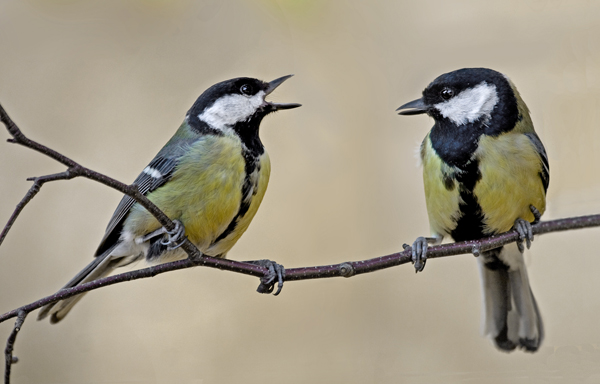(White-crowned sparrow, Zonotrichia leucophrys)
The two collaborators designed a study allowing them to use Baptista's data to answer three major questions: First, did urban noise levels increase between 1969 and 2005 and, if so, was it related to increases in car traffic? Second, assuming there were changes in ambient noise levels, were there any accompanying adjustments in white-crowned sparrow songs--specifically, did the sparrows show the same sort of song variations previously documented between urban and rural, or noisy and quiet territories? Finally, do current birds respond more strongly to historical or modern songs?
Eight of Baptista's recordings were collected from an area of San Francisco in which resident sparrows sang what has since (appropriately) been labeled the San Francisco dialect. This area was revisited in 2005 so that additional males (a total of 12) could also be recorded. Nearby stands the Golden Gate Bridge, with all its noisy traffic. This inspired the researchers to examine whether long-term changes in ambient noise were related to corresponding variations in traffic; information on both of these variables was extracted from documents produced by local and federal governments.
(The iconic Golden Gate Bridge: a source of noise that impacts local wildlife)
For the final part of the study, Luther visited the territories of 20 resident males and exposed them to broadcasts of both historical and contemporary recordings. Each male heard one pair of songs--only one song per day, randomly selected, and with a rest period of at least two days between each exposure. The intensity of each male's response was assessed in two ways: his general behaviors (speed to approach the speakers, closest approach to the speaker, number of flights near the speaker, number of wing waves) and vocal behavior (latency to deliver the first song, total number of songs produced).
As expected, the researchers found that San Francisco has grown significantly louder over the last 35 years. In fact, with an average increase of slightly over 5 dB (from 66 dB to 71), it has become nearly twice as loud. Over the same time period, traffic flow has increased by 19%. Likewise, male songs changed noticeably between 1969 and 2005. Of 18 song characteristics measured, five varied significantly, and four of these were related to minimum or dominant frequency--the song trait most commonly observed to change in relation to ambient noise levels. Specifically, modern males have shifted their frequencies upward. Contemporary territory holders can clearly distinguish these differences: Males responded to current songs more quickly and more intensely than to those from historical recordings.
(Great tits, Parus major--perhaps the best-studied species in the context of anthropogenic noise)
It is not easy to pinpoint the exact mechanism behind the patterns observed here. They may simply be the result of drift--or, in other words, an artifact of sampling techniques and/or random cultural survival of one type of song versus another. Alternatively, they could represent a true adaptive response to anthropogenic noise. If this is the case, though, it is not clear whether modern song is a result of cultural evolution, behavioral plasticity, or some combination of the two.
In all, though, there is strong evidence that increases in traffic led to increases in ambient noise, which, in turn, led local males to adjust their songs in order to maintain (or even improve) their ability to perform effective vocal displays clearly marking the edges of their territories. The temporal adjustments are particularly striking in comparison with changes made by the same species over the same time period in nearby rural areas. There, several populations of white-crowned sparrows actually sing lower minimum frequencies--a variation caused not by anthropogenic noise (of which there is very little), but by changes to habitat structure. Urban sparrow vocal manipulations are also strikingly similar to those observed elsewhere in several other species of city-dwelling bird, including great tits (Parus major) and song sparrows (Melospiza melodia).
(Song sparrow, Melospiza melodia--another of the growing number of avian species known to vocally respond to anthropogenic noise)
Perhaps the most intriguing finding here is that the vocalizations that are more "appropriate" for a given noise regime are also better at eliciting a response from an avian audience--in this case, potential rival males. This suggests that birds in noisy areas may need to adjust their songs to be able to communicate effectively; those that don't are in danger of being ignored, or at the very least being taken less seriously. While this was only studied here for male-male interactions, it may also be true for male-female interactions, which, obviously, play an important role in perpetuating a species. In the future, then, it will be interesting to see how signal efficacy is impacted by anthropogenic noise, and also to investigate the implications of noise pollution in species that do not display vocal flexibility.
---
Luther, D.A. and E.P. Derryberry. 2012. Birdsongs keep pace with city life: changes in song over time in an urban songbird affects communication. Animal Behaviour 83:1059-1066.
Thanks to the following websites for providing the images used in this post:
http://www.outdooralabama.com/watchable-wildlife/what/Birds/passerines/wcs.cfm
http://en.wikipedia.org/wiki/File:GoldenGateBridge.jpg
http://en.wikipedia.org/wiki/File:GreatTit002.jpg
http://sdakotabirds.com/species_photos/song_sparrow.htm




No comments:
Post a Comment